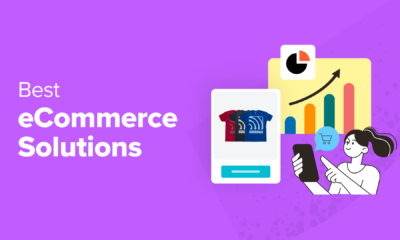WORDPRESS
9 Best Printify Alternatives (2023 Comparison)

Welcome to our comparison of the best Printify alternatives.
Printify is one of the most well-known print on demand companies on the market, but that doesn’t mean it’s the best.
In this post, I’ll be sharing some other print on demand solutions that you can use instead of Printify. And I’ll tell you everything you need to know about each of them, including their features, pros, cons, pricing, and more.
Ready? Let’s jump into it.
The top Printify alternatives compared
TL;DR:
Gelato is the best alternative to Printify for most users, particularly those with an existing ecommerce store.
You can integrate directly with most ecommerce platforms out of the box. For example, Shopify, WooCommerce, Etsy, etc.
In our tests, we were impressed with the level of quality, selection, and turnaround times. Support was solid as well.
For those that don’t have an existing store, be sure to check out Sellfy. It’s an ecommerce platform that allows you to sell all kinds of products, including print on demand merchandise.
#1 – Gelato
Gelato is our top pick for the number one Printify alternative. Its competitive prices, high-quality product catalog, and wide range of integrations make it one of the best print on demand solutions on the market right now.
Gelato works in a similar way to Printify. You sign up, connect it to your existing store, and design and import products from the Gelato catalog.
Then whenever a customer purchases one of those products, Gelato will print it and ship it for you on-demand. And of course, you only pay for what you sell—there are no upfront costs.
The platform partners with 130+ production facilities spread over 32 countries. So you can sell orders globally but have them produced locally in the customer’s country for faster deliveries.
Products and shipping are very affordable. You can save up to 50% on standard shipping with paid plans.
The Gelato product catalog is excellent too. They have hundreds of products in all the most popular categories: Apparel, wall art, mugs, tote bags, and phone cases. The catalog also includes some more unique products, such as photo books, stationery items and even flyers and brochures.
There is also a dedicated category for kids and baby clothes, which is helpful if you want to create POD products for kids.
What about print quality? Gelato’s print quality is quite high thanks to cutting-edge printing technology and sustainably-sourced materials from some of the best brands.
Gelato also closely monitors production workflows for each printing partner to ensure the best quality possible.
Key features
- 130+ global printing partners
- Tax & VAT handling
- Shipping discounts
- Multi-currency
- Mockup studio
- Custom packaging
- Mobile app
Pros
- Cheap prices
- Easy to use
- Great feature set
- Good quality
- Fast shipping
Cons
- Stock images require a paid subscription
#2 – Printful
Printful is another one of the most popular print on demand fulfillment providers in the world, alongside Printify. But we’ve found that Printful’s quality is a little more consistent and reliable.
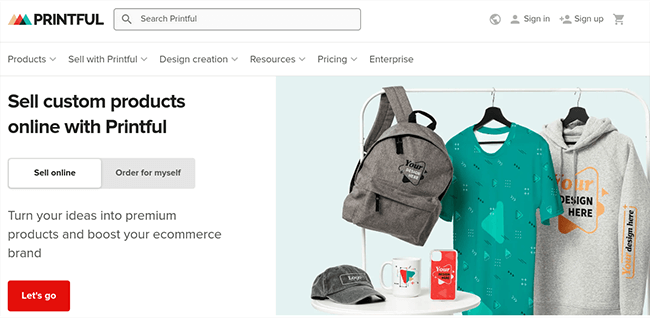
The reason Printful is more consistent than Printify is that, unlike its main competitor, Printful owns its own printing facilities.
You see, Printify is more like a middleman: It outsources your orders to its global fulfillment network of third-party print partners. As a result, quality is inconsistent. How ‘good’ the print is will pretty much depend on which partner processes the order.
This isn’t as much of a problem with Printful, because it runs its own global fulfillment centers. Everything is centralized, and Printful is able to implement strict quality control measures across the board.
Another thing we like about Printful is that it offers a lot of branding options. You can customize the labels on your products with your own brand, as well as the packaging. And you can even add inserts like packing slips and thank you cards for an extra personalized touch.
Printful also offers a great selection of products, from clothing and apparel to hats and accessories. It also has a dedicated category for home and living that includes items like canvas prints and wall art, bedding and blankets, candles, coasters, and more.
Aside from that, Printful and Printify are very similar. They both integrate with a wide range of ecommerce platforms and come with beginner-friendly design tools that make it easy to put together your POD products and import them to your store.
Printful’s free plan comes with everything you need to start selling, but you can upgrade your experience by signing up for a paid monthly subscription. Paid users get access to premium features like custom pack-ins and packaging, additional branding options, and more.
Key features
- Global fulfillment
- Ecommerce integration
- Design Maker
- Logo Maker
- Quality control
- Warehousing services
- Branding options
- White-label packing slip
- Custom pack-ins & packaging
Pros
- Good quality control
- In-house global fulfillment network
- Easy to use
- Excellent integrations
- Branding options
Cons
- Small margins
- Requires existing website/store
- Sometimes exceeds estimated shipping times
#3 – Sellfy
Sellfy is the best Printify alternative for users that don’t already have an existing website. You can use it to build your own online store from scratch and start selling print-on-demand merch, as well as other products.
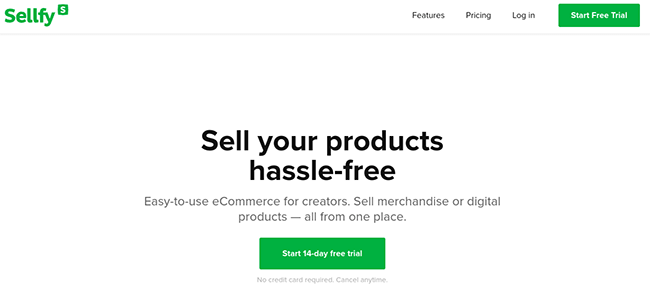
Unlike Printify, Sellfy isn’t just a print on demand company. It’s a full-fledged ecommerce platform that gives you everything you need to build a store and manage your online business.
That includes a drag-and-drop site builder, order and inventory management features, integrated checkout, marketing tools, and more.
But what makes Sellfy different from other ecommerce platforms like Shopify is that it also has its own built-in print-on-demand functionality.
Once you’ve signed up and created your store, you can access Sellfy’s print-on-demand catalog from your dashboard, customize their products with your own designs, and add them to your product list.
When a customer places an order, Sellfy will fulfill it for you by printing and shipping the order straight to them, and bill you for the product and shipping afterward.
Sellfy offers a wide selection of POD products for you to choose from, and it has a particularly good selection of clothing products, including shirts and hoodies in different styles and materials.
You’re not limited to print on demand products either. You can also sell regular products, digital products, and even subscription memberships. This makes Sellfy a great choice if you’d like to have more flexibility when it comes to your product catalog.
You can try Sellfy out for free. Paid plans start from $19-$29/month depending on your billing term (i.e. monthly, yearly, or two-yearly). There are no additional transaction fees on regular sales.
Key features
- Store builder
- Shopping cart
- PayPal & Stripe integration
- Email marketing
- Upselling
- Discount codes
- Buy now buttons
- Print on demand
- Digital products
- Physical products
- Subscriptions
Pros
- Complete ecommerce solution
- Lets you build your own store
- Fully-integrated print-on-demand
- Easy to use
- Feature-rich
Cons
- Requires monthly subscription
- Only accepts PayPal and Stripe payments
#4 – SPOD
SPOD is another one of our favorite print-on-demand service providers. It has its own in-house fulfillment centers in Europe and the US, and an excellent reputation.
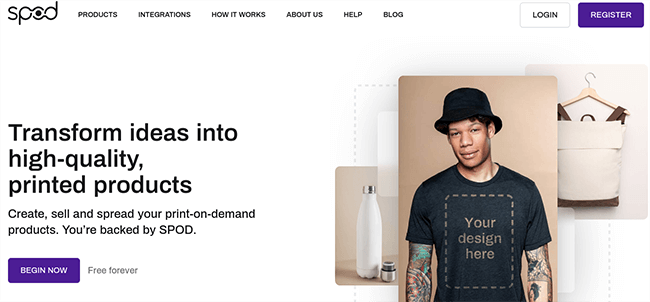
When you first sign up for SPOD, you’re asked to choose where you want your orders to be produced: the US or the EU.
They have four of their own production sites, one in each of the following places: Germany, Poland, the Czech Republic, and Nevada, US. And they don’t work with any third-party providers.
If most of your customers are US- or EU-based, delivery times should be pretty fast as orders will be produced locally.
You can still sell elsewhere as SPOD ships worldwide, but outside of the EU and US, shipping times will likely be a lot longer.
SPOD’s catalog is pretty extensive, with over 200 different products. And they’re reasonably good quality for the most part.
The platform itself is easy to use, so you can easily add your designs to their products. They even provide over 50,000 premade graphic designs that you can use.
You can then import those products to your store for automated fulfillment via SPOD’s native integrations. It’s easy to plug it into Shopify, WooCommerce, Amazon, Ebay, and most other popular ecommerce platforms/CMS.
They offer 48-hour production so products get shipped fast, and discounts of up to 20% for test samples.
Key features
- US/EU facilities
- Worldwide shipping
- Easy integration
- Product designs
- Sustainable production
- Organic collections
- Samples
Pros
- Good product quality
- Owns its own production sites
- Fast 48-hour production
- Great design tools
Cons
- Only EU/US production sites
- Smaller catalog than some alternatives
#5 – Zazzle
Zazzle is a popular print on demand marketplace where shoppers can buy custom products from independent artists. It’s a great, hassle-free alternative to Printify for beginners that want an easier way to get started.
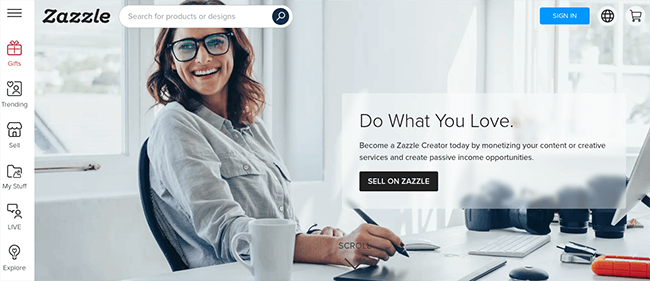
What makes Zazzle so great is how easy it makes it to start your own POD business.
Unlike Printify, you don’t need to create your own website and do all your own marketing to get traffic and make sales.
Instead, you just sign up and list your designs for sale in the Zazzle marketplace, which already gets tend of thousands of monthly visitors.
In just a few minutes, your designs will be visible to millions of shoppers. If they come across your stuff while browsing and buy it, Zazzle will print and fulfill it for you, and then pay you royalties. It’s totally hands-off. You can set your own royalties for each design too.
There are lots of products in Zazzle’s catalog that you can add your designs too: invitations, wall art, homeware, electronics, gifts, clothing, accessories… you name it, it’s probably available.
And it’s easy to customize them in the built-in editor. There are a bunch of design assets you can use like graphics, emojis, etc. or you can just upload your own designs from your computer.
Key features
- Zazzle Marketplace
- Seller store
- Product designer
- Premade templates
- Premade illustrations
- Custom royalties
- PayPal payments
- Affiliate program
- Free Adobe plugin
- Community forum
- Zazzle LIVE program
Pros
- Existing customer base
- Good product selection
- Design and selling tools
- Beginner friendly
Cons
- Very competitive
- Less control
#6 – Redbubble
Redbubble is another uber-popular print on demand marketplace like Zazzle. It gets millions of visitors every month, but it’s very competitive.
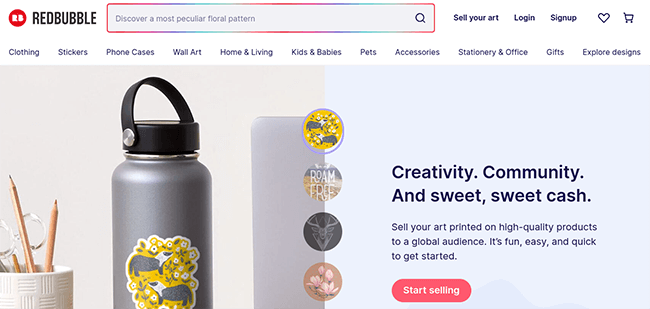
Redbubble offers global fulfillment and has visitors from all over the world, so you can reach pretty much any market.
There are over 70 unique print on demand products in their catalog for you to add your designs to, including all the staples: t-shirts, masks, mugs, etc.
Flexible pricing means you can control what you earn and add your own markup to each item you sell. And of course, it’s completely hands-off as Redbubble prints to order and takes care of all the fulfillment for you.
My one gripe with Redbubble is that it’s a little oversaturated at this point. There are a lot of sellers there, so it can be hard to cut through the noise and get eyes on your designs.
Plus, there’s always the risk that someone will shamelessly rip off the designs that you worked hard on and undercut you. That said, Redbubble does have anti-piracy and watermark features to help mitigate that risk.
Key features
- Marketplace
- 70+ unique products
- Easy design upload process
- Flexible pricing
- Anti-piracy tools
- Customer support
- Promotions
Pros
- Huge customer base (30 million+ shoppers)
- Easy to get started
- Control your own prices
- Good selection of products
Cons
- High competition
- Risk of other sellers copying your designs
#7 – Amazon Merch On Demand
Amazon Merch On Demand is Amazon’s very own print on demand program. You can sign up to sell your designs on the Amazon marketplace and earn monthly royalties.

By far the best thing about Merch by Amazon is that all the products you sell will be eligible for Prime Shipping.
This is a huge game-changer, as it means your customers can receive their POD orders lightning fast in just two days. Whereas with other print on demand providers (like Printify), they might have to wait weeks for deliveries.
Another cool thing about it is that Amazon has enormous reach. Literally hundreds of millions of people around the world shop on Amazon every month, which means there should be plenty of opportunity to get eyes on your products.
It’s very straightforward to get started too. All you have to do is sign up, upload your artwork, and choose the product you want to add it too. You can then customize the color and add your product description, and Amazon will create a product page for it on the marketplace.
When a customer buys it, they’ll print what’s sold and handle all the production, shipping, and customer service. All you have to do is collect your royalties.
The downside? Margins are pretty low. Royalties are calculated based on the product’s purchase price minus tax and Amazon’s costs, but expect to earn around 4-5 bucks on a typical $19.99 t-shirt sale.
Oh, and there’s also the fact that the program isn’t open to anyone. You have to submit an application to sign up for a Merch on Demand account, and there’s no guarantee you’ll be accepted. You’ll be notified by email as soon as they’ve processed your request.
Key features
- Amazon product page
- Global fulfillment
- Prime Shipping
- Analytics tools
- Flexible pricing
- Easy design uploads
Pros
- Huge global reach
- Trusted brand name
- Straightforward payout system
- Rapid deliveries with Prime Shipping
- No upfront costs
Cons
- Low profit margins
- Application required (not open to anyone)
#8 – Inkthreadable
Inkthreadable is a UK-based print on demand supplier that stands out for its excellent product and printing quality.

If you hadn’t heard of Inkthreadable already, I wouldn’t be surprised. They’re not as popular as the ‘big’ print on demand providers like Printful, Printify, Teespring, etc. But that’s actually to their strength. Here’s why.
Because Inkthreadable runs a smaller operation, they don’t cut as many corners and rush their work in the name of mass production like a lot of other providers do. As a result, their prints tend to be really good quality.
If Printify’s let you down in the past in the quality department, you might prefer what Inkthreadable has to offer. Their commercial quality shirts are really nice. In particular, we really like the Stanley/Stella range of clothing, which uses high-quality organic cotton. And we’ve never been disappointed in the printing quality either.
Because Inkthreadable is based in the UK, it’s naturally a good fit for businesses who’s customers are mainly in Europe. Shipping times will be super fast inside the UK as they’re printed and packed locally, and reasonably-fast to EU countries.
But if you cater to customers on the other side of the pond, it’s not as ideal. Standard shipping is still fairly affordable to the US, but expect to be waiting weeks for deliveries.
Setting up Inkthreadable is easy. It integrates with all the leading ecommerce platforms including WooCommerce, Shopify, Etsy, Wix, and more.
If you run into any problems setting things up, you can usually find a solution in Inkthreadable’s extensive help center. Or if you want to speak to a real human, live chat support is available from 9-5 every weekday.
There’s a good selection of products in Inkthreadable’s product catalog (around 250+ in total). There’s also no minimum order quantity and everything is automated so orders that come in through your online store are automatically sent to Inkthreadable, who send them straight to your customers.
Key features
- Drag-and-drop product designer
- Worldwide shipping
- UK-based fulfillment center
- Ecommerce integrations
- No minimum orders
- Eco-friendly product ranges
- Live chat support
Pros
- Superb quality products
- Excellent product materials
- Easy to use
- Great for UK and EU sellers
- Good support
Cons
- Only one fulfillment center
- Slow delivery times to US
#9 – Awkward Styles
Awkward Styles is one of the print providers that Printify works with. So why not cut out the middleman and go to them directly instead?
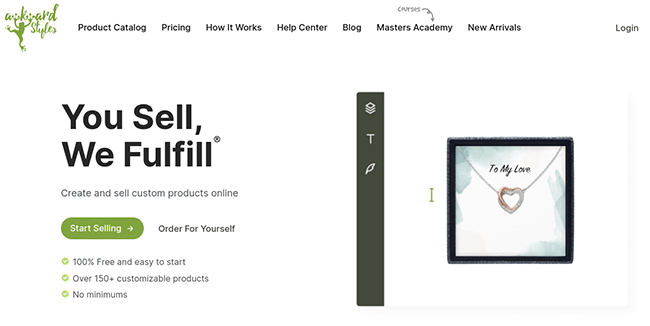
Naturally, working with Awkward Styles directly rather than via Printify means you get better pricing and higher profit margins. And you can get even better prices if you sign up for the Pro plan, which comes with a 20% discount on all the products in their catalog.
All of Awkward Styles fulfillment facilities are based in North America, so if you’re selling to customers in the US, expect fairly fast delivery times. Outside of the US, you’ll be waiting a lot longer.
We really like Awkward’s mockup builder too, and the automated order import process keeps things simple.
Quality is pretty great too. They have top-of-the-line printing equipment and offer a range of printing options/methods, including DTG on apparel and Sublimation on home decor, living, and accessories.
You can get started with Awkward Styles for free, but to access those hefty discounts and premium features like the design library, custom API integration, and warehousing services, you’ll need to sign up for a paid plan.
The Pro plan starts from $25/month . You’ll need to request a quote to sign up for the Pro+ plan (suitable for merchants with over 500 daily orders).
Key features
- Print on demand fulfillment
- Mockup generator
- Ecommerce integrations
- Unlimited designs
- Discounts
- Design library
- Warehousing service
- Help center
- Customer support
Pros
- Cheaper prices
- Great mockup builder
- Good quality
- Fast shipping in US
Cons
- Support can be hit and miss
- No fulfillment centers outside of the US
Printify pros and cons
Before we wrap up, let’s look at some of Printify’s pros and cons.
Printify pros
- Reasonable margins. Printify’s product & shipping costs are lower than many of its competitors, which means better profit margins for you. The reason for this is that Printify works with tons of third-party fulfillment providers who have to keep their prices competitive in order to win your business.
- Huge catalog. There are over 800 products in Printify’s catalog for you to choose from, and that includes some very niche items that you’ll struggle to find elsewhere. That’s also significantly more than most of its competitors (twice as many as Printful, for example).
- No upfront costs. With Printify, you only pay for what you sell. There’s no need to pay monthly subscription fees like you might with other platforms, like Sellfy.
- Easy to use. Another big thing that Printify has going for it is its ease of use. It’s designed to be as beginner-friendly as possible, so it’s super easy to integrate with your online stores, upload your designs, and import products.
- Great for international shipping. Printify has the largest global print network of any print provider, which makes it ideal for international shipping. No matter where your customers are, there’s a good chance Printify will be able to route it to a fulfillment center in their country for faster delivery times.
Printify cons
- Works with third parties. Unlike many other print-on-demand providers, Printify doesn’t actually own or run any of its global fulfillment centers. Instead, it acts like more of a middleman and works with many different providers. It’s these third parties that actually print and ship your orders.
- Inconsistent quality. Because Printify doesn’t own its own fulfillment centers, it has little to no control over quality. The quality of your prints will vary depending on who the printer is, so it’s fairly inconsistent.
- Requires an existing website. Unlike Sellfy, Printify isn’t an all-in-one POD ecommerce solution. It just provides the backend fulfillment services, but you’ll need an existing website/store where you can actually sell your products through.
Choosing the best Printify alternatives for your business
That concludes our roundup of the best Printify alternatives.
With so many choices out there, it can be tough to figure out which one is right for your print on demand business.
If you’re struggling to choose between them, I’d suggest one of our top three picks:
- Gelato is the best overall Printify alternative for most businesses. If you’re not looking for anything specific and just want a print on demand site that offers good quality, good turnaround times, solid integrations, and a nice catalog, this is the way to go.
- Sellfy is the best choice if you don’t already have an existing store to sell your merch through. It’s one of our favorite ecommerce platforms. Use it to create a website and start selling all sorts of products, including print on demand.
- Printful is the best like-for-like alternative to Printify. It’s very similar in many ways but has more consistent quality as it controls its own fulfillment centers rather than relying exclusively on third parties.
Not sure you want to start a POD business after all? Dropshipping is a popular alternative. Here are some posts to help you get started:
Good luck!
Disclosure: This post contains affiliate links. This means we may make a small commission if you make a purchase.











